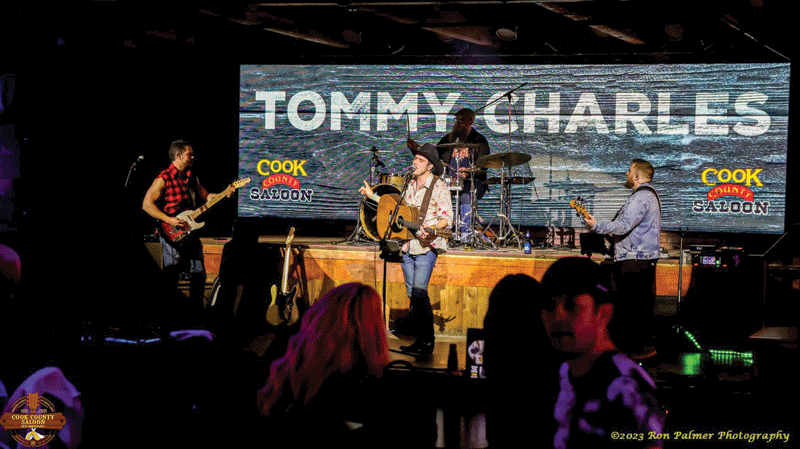
For the last decade, VueTronic has helped sign shops and digital integrators across Canada deliver cutting-edge and reliable projects. Photo © Ron Palmer Photography/courtesy VueTronic
By Carly McHugh
With the rise of new technology, smarter systems, and increasingly sharper pixel pitches, the world of digital LED signage continues to evolve—and it is crucial for sign shops and their clients to keep up.
Enter VueTronic, a wholesale LED display provider with an eye towards the future. Founded by partners Terry Balaban and Bill Shepansky, the Edmonton-based company has helped sign shops and digital integrators across Canada deliver cutting-edge and reliable projects for the last decade. They also provide comprehensive support services and software solutions to ensure each sign runs smoothly for years after installation.
Sign Media Canada spoke with Balaban and Shepansky about the history of VueTronic, as well as recent projects, new developments in digital LED signage, and their plans for the future of the company.
Sign Media Canada (SMC): What is the history of VueTronic?
Terry Balaban (TB): Bill and I both come from the advertising world, in broadcasting and newspaper, and we started a company that was originally selling advertising. We had some of our own locations and we had locations we were contracted to sell, and as we were selling advertising, customers would ask us where they could get a sign of their own, and if we were able to help them out. From there, we morphed into a wholesale LED display company.
Bill Shepansky (BS): We travelled extensively to source and learn about LEDs. Now, we work with some of the biggest factories in the world, to pick and choose products that are going to sell in Canada and are built for our climate. We have to source quality LED products, because of the extreme temperatures. That’s how we became a true wholesale company.
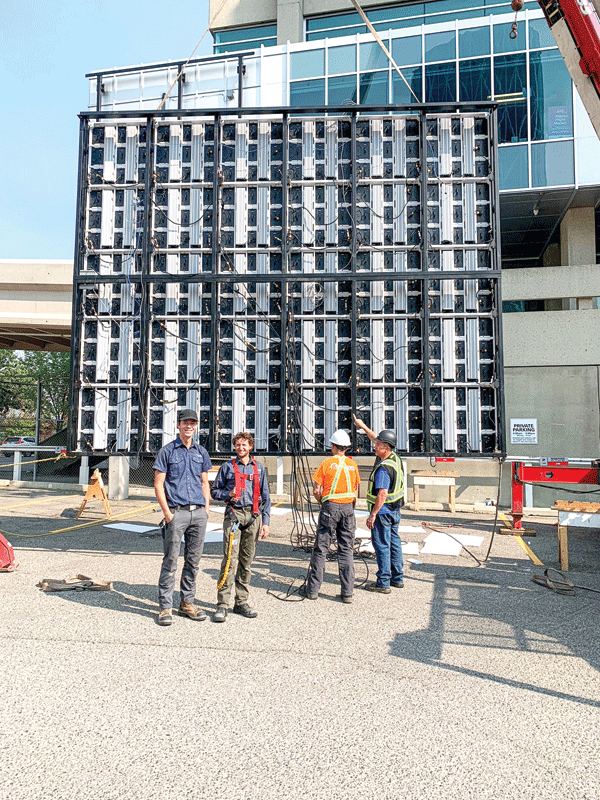
The company also recently received a first-place award from the Alberta Sign Association for two LED displays at Bow Valley College in downtown Calgary. Photos courtesy © VueTronic
We’re in a time of continual breakthroughs and product advancements. Currently, we’re sourcing for billboards, superboards, transparent window signage, high-bright LED signage that can break through sunlight, and the world of micropixels. Our top seller is a 1.2- x 2.4-m (4- x 8-ft) outdoor display with a 10-mm (0.3-in.) pixel pitch, so we try to keep it in stock for quick turnarounds. We’re committed to staying current and being a reliable resource for sign shops.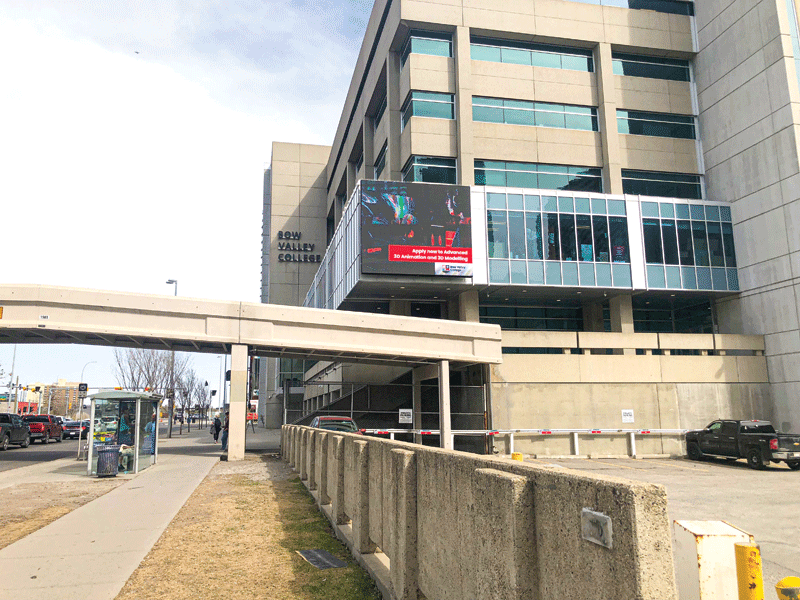
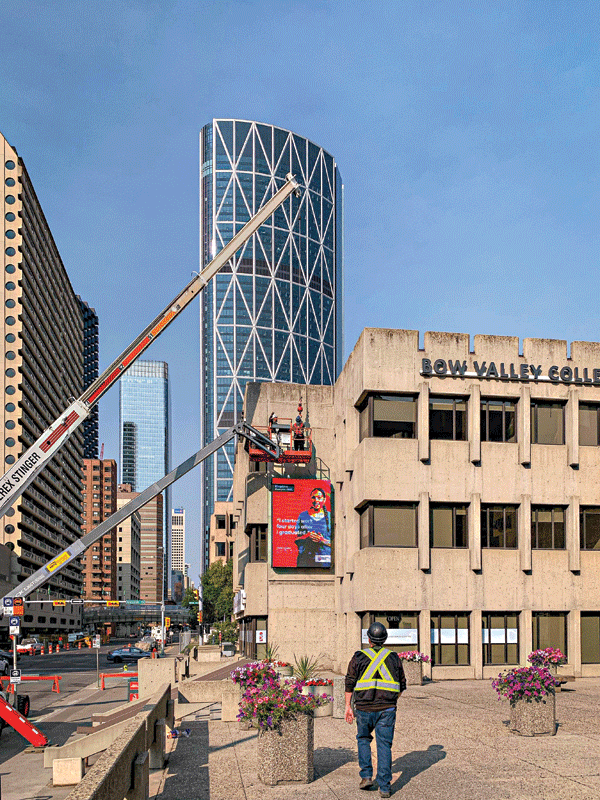
SMC: What makes your company unique?
BS: VueTronic’s success is built on providing high-quality LED displays and first-class customer support. We know LED displays and how to keep them running for the lifetime of the sign. We sell our displays through sign shops and train the end-users on how to upload and manage their content. Should they have any issues with the sign, they can call us, and we can troubleshoot the problem remotely. They call VueTronic for assistance, not the sign shop. This alleviates frustration for our partners and is one of our unique selling propositions.
TB: We also provide them with a quality product that is aggressively priced. The sign shops then have the opportunity to mark up the displays to increase their revenue on the project, which is a great way to generate a new income stream for traditional sign shops. Plus, our displays come complete—wired, bench-tested, and ready to install.
SMC: How large is your facility, and how many employees do you work with?
TB: The facility we utilize for manufacturing our displays—where we receive parts, where frames get built, and where they ship from—is 929 m2 (10,000 sf). This is also where we ensure they meet Canadian standards and codes. Additionally, we have a showroom at our main office location, where we have several products on display in various sizes, styles,
and pixel pitches.
BS: A lot of the time, we engage engineers, fabricators, welders, electricians, and/or installers for each custom project. We want the sign shops to make as much money as possible on the design and fabrication aspects. VueTronic’s role, and our core business, is providing the LED displays.
SMC: What types of solutions and services do you provide to your customers?
BS: We have hundreds of signs all over Canada, and many examples of projects we’ve accomplished. Our biggest project to date, in terms of size and scope, is at Edmonton’s Commonwealth Stadium. VueTronic partnered with Bruce Simpson at William Huff Advertising, and was awarded the project with the caveat that no screws or drills could be used in the installation that would weaken the stadium’s structure. Instead, we created a hanging system at the mid-bowl level to hang the entire power ring. The client was so impressed with our work that the following football season, they added impact-reducing sideline signage around the field, along with many other digital products around the stadium—such as ticket outlet LEDs, pylon LEDs, a video wall, and a special program we designed for their new LED stat board. It’s a keystroke program that brings up a player’s bio and keeps the content engaging for their viewing audience.
Meeting clients’ expectations can be challenging. We need to work closely with them, so we all understand what they want the sign to accomplish, because these displays are capital investments. We try and make sure we understand the project and discuss connectivity options, which software would work best, or how the display can be integrated with the technology they’re already using.
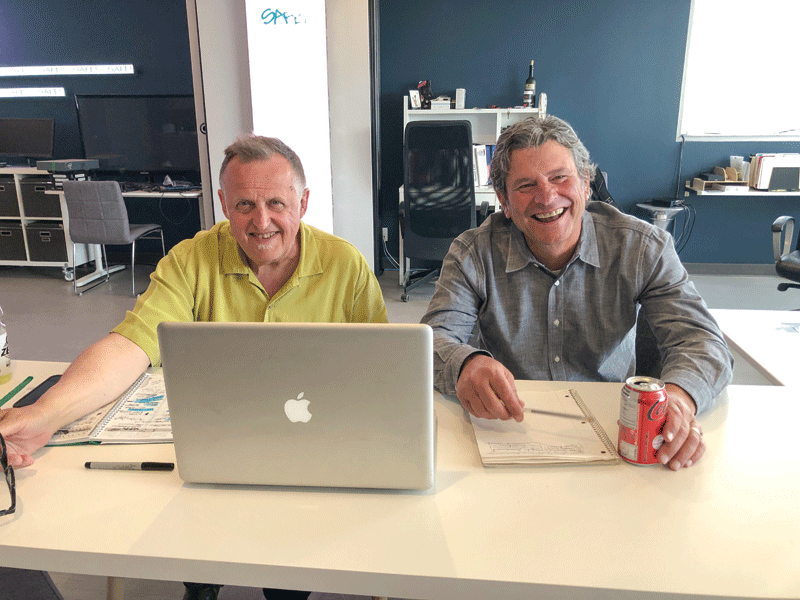
The Edmonton-based LED display provider was founded by partners Terry Balaban and Bill Shepansky.
TB: If something goes wrong with a display, it goes back to the service and support. We’ve managed so many signs now, we can pinpoint what the problem could possibly be. We have remote access to our signs and can have a quick look to help determine the issue. Almost always, it’s either a connectivity problem, a computer upgrade that messed up the system, or someone in the office fiddling with the sign, which caused it to go offline. We offer lifetime technical support, because clients’ staff change, networks disconnect, power supplies surge, and more. However, it’s all easily fixable.
SMC: What are some of the projects you’ve been working on recently?
BS: We recently received a first-place Best of Alberta (BOA) award from the Alberta Sign Association (ASA) for our Bow Valley College project in downtown Calgary. This project required high-quality, custom-built, dynamic displays that would transform the rebranding of the campus. The LED install was strategically designed by Krawford Construction to cover existing windows and mount into existing structures, with the help of Sunmar Contracting. The software needed to interface seamlessly with the college’s existing digital platform. This award-winning project was a complete success, and now, whether you’re going eastbound or westbound by the Bow Valley College campus, you’ll see two stunning LED displays with eye-catching creative content, right in the heart of downtown Calgary.
We also won third place in the same digital signage category, for the 1.8- x 6-m (6- x 20-ft), 2.4-mm (0.1-in.), small-pitch stage backdrop at Edmonton’s historic Cook County Saloon. It’s a stunning LED backdrop for performers, in-house promotions, live dance feeds, event sponsors, and more. The saloon required the display to interact with their existing video and audio infrastructure. It immediately transformed the customer experience and elevated the stage presence of the performing artists and bands.
Additionally, we have a client who is a Burger King franchise owner, and they couldn’t be happier with the attention their digital board is attracting on Calgary Trail—one of the busiest streets in Edmonton. They’re even more pleased with how easy it is to upload and change its content using a simple tablet.
TB: We’ve even worked on special rental projects, such as the ATB Classic Professional Golfers’ Association (PGA) Tour, elevating their sponsorship opportunities and creating an unparalleled guest experience. With the live streaming capability of the display, every seat became “the best seat in the house.”
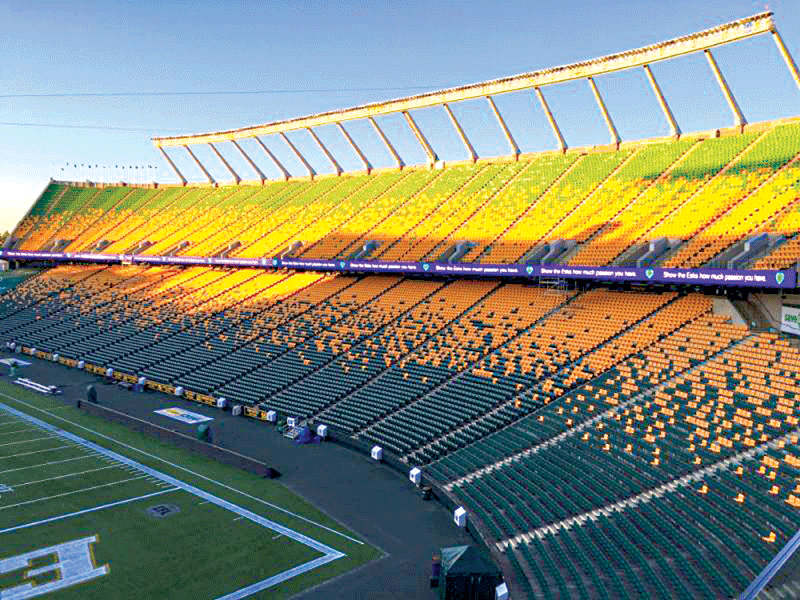
VueTronic’s biggest project to date began with a power ring at Commonwealth Stadium. They later returned to implement additional digital solutions.
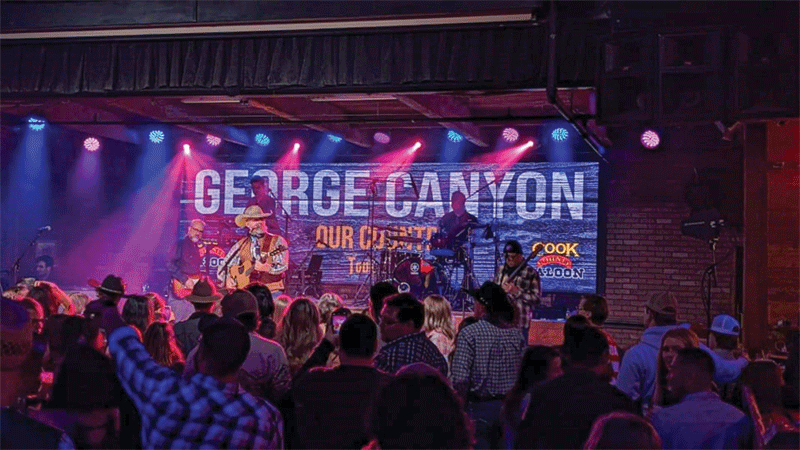
Another project at Edmonton’s historic Cook County Saloon earned them third place in the same award category.
Many municipalities also want to broadcast their welcomes, weather warnings, evacuation instructions, amber alerts, fire bans, time/temperature/air-quality updates, big events, local art, and other community messaging on an LED board. Sometimes the signage fits into their revitalization, digital transformation, or beautification budgets.
SMC: How much of your fabrication process is handled in-house?
BS: We manufacture the entire display in-house, and work closely with the project co-ordinator and shop drawings for the most efficient way to install it.
Our role is to support our sign shops. We don’t submit on requests for proposals. We supply our partners with the tools and metrics they need to win the project, with detailed custom display specs and what’s required for the network and communication. We walk them through the entire process, so when they put the electrical in, they know what they need for the digital portion to function properly.
TB: Going back to what sets us apart and makes us unique, that’s exactly it. The sign shops are good at building, fabrication, and installation. We’re LED experts, and that’s where we come into play. We send you the LED sign, custom-made to your specs and ready to install.
SMC: What are some of the tools and equipment you use to complete your projects?
BS: We’ll get involved with how our signs are going to integrate into their structures, and the outcome in terms of pedestrian traffic, vehicle traffic, or height. We’ll custom-make solutions for each project, so when we deliver our portion, it’s ready.
TB: Our tools aren’t screws and drills. We come in with tools from a technical point of view. A client may want to put their sign on an existing network, so we figure out how we’re going to integrate it. Others might want to keep it separate or be able to access it from their lawn chair or anywhere in the world. Those are the skillsets we bring to each project.
SMC: What are some of the steps involved in your planning process?
BS: Before a sign shop even gets the project, we’re usually involved in how it’ll go together, and it’s about communication. It’s about staying in touch, whether it’s the electrical or the data. Being strictly LED experts, we understand exactly how the displays communicate and operate. We can do it in any number of ways and adapt to each individual project. We can make recommendations on sizes and pixel pitches depending on the viewing distance and offer our advice for achieving a good-quality picture with the pixel matrix.
TB: Additionally, as part of our education process, we like to do lunch and learns. We like to get in front of sales teams, share the knowledge we have with them, and give them some tools and understanding, so when they present an idea or a project to their clients, they’re able to speak confidently about LEDs. Once they make a sale, we arm the salesperson or the sign company with a pre-install checklist.
“Who’s your electrician? Who’s going to do the electrical hookup? Would a Wi-Fi bridge work? Would an app be easier? Who’s your IT guy? Do you have one?”
We go through all of the steps, so we’re able to contact all of those people—because they’re going to have questions about the new sign that’s coming in—and everything gets lined up, so when the sign arrives, there are no surprises. Everybody knows what to expect, and everybody knows what has to be prepared in anticipation of receiving the sign.
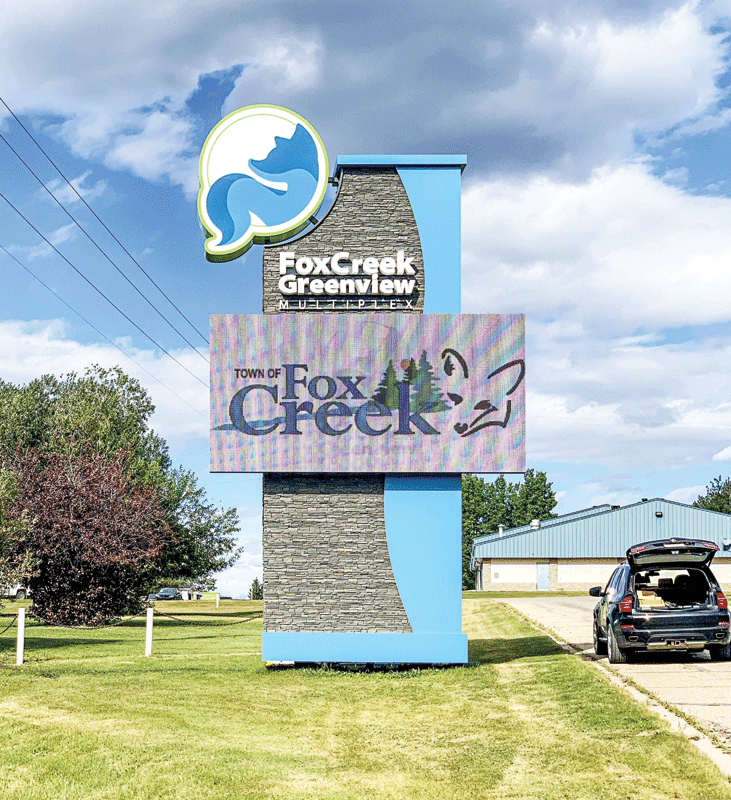
In addition to digital LED signage, the company provides lifetime technical support, to ensure the longevity of its projects.
BS: With honest communications, you can also manage client expectations and make sure everybody’s on the same page. For example, if there’s a delay in shipping, you can communicate the issue to your client, and they can plan around it. It just makes everything go more smoothly and helps build trusting relationships.
SMC: How has technology changed the way you operate your business?
TB: LED signage has the capability to inform, educate, entertain, communicate, and promote your business. Now, with the ability of dynamic programming, many clients don’t understand the power of that technological capability. It can detect whether it’s the morning and your sign should be running breakfast ads, or if it’s the evening and it should switch to dinner promotions. If you’re driving a Ford vehicle, it can shift to Ford advertising, or if you’re female, it can switch to ads designed to target women. Artificial intelligence (AI) is changing and enhancing how digital signage is deployed, faster than buyers can understand it. You can even do live feeds for events and include your social media platforms. Some companies focus on the “front-of-house” for engaging customers and advertising promotions, while others use the displays for staff room communications, corporate messaging, and social media. One client replaced their whiteboard system, tracking when and where trucks were being sent out, to a slick digital tracking and deployment LED system. There are unlimited ways to utilize LED signage and technology.
Even when it comes to our traditional methods of installation, a computer and Category 5/6 (Cat 5/6) cables are a general guideline. The technology is moving so fast, there’s now software available where you can just download an app, upload your content, and you’re done.
SMC: How is your approach towards LED signage revolutionizing the industry?
BS: We have the ability to source products from anywhere in the world. We’re not tied to any one factory or any software, but we do have our favourites. We’re very much a purpose-built, custom LED display company.
If you look at any major market, screens are everywhere, and growing. VueTronic is committed to being a relevant and reliable resource for sign shops and helping to make the adaptation to the world of LED signage as easy as possible, for themselves and their clients.
TB: We need to empower salespeople with inspiration and understanding, to be able to see the vision where traditional signage would be OK, but a modern LED digital display could change, modernize, and benefit their client’s business.
SMC: What are some challenges the industry, or your company specifically, is currently facing, and how do you navigate those challenges in order to stay successful?
BS: We face similar challenges to what our sign shop partners are going through: the Canadian dollar, shipping timelines, the price of goods, sticker shock, staggering long sales cycles, permits, one-and-done—see you in
10 years. Education is also a challenge. We try to do as many learning sessions as we can, giving sign shop owners, managers, estimators, and salespeople the confidence to speak about LEDs knowledgeably and discuss the possibilities of how their clients can benefit from the capabilities of the technology.
TB: Another challenge we face is when a client invests in a beautiful LED display and then neglects running engaging, compelling content—or worst of all, poorly sized creative that makes the sign look horrible. We jokingly refer to that as a “bad signage citation,” but it happens more often than you think. VueTronic even offers creative services to help alleviate this problem, but it’s difficult when customers don’t understand the capabilities of their LED display investment.
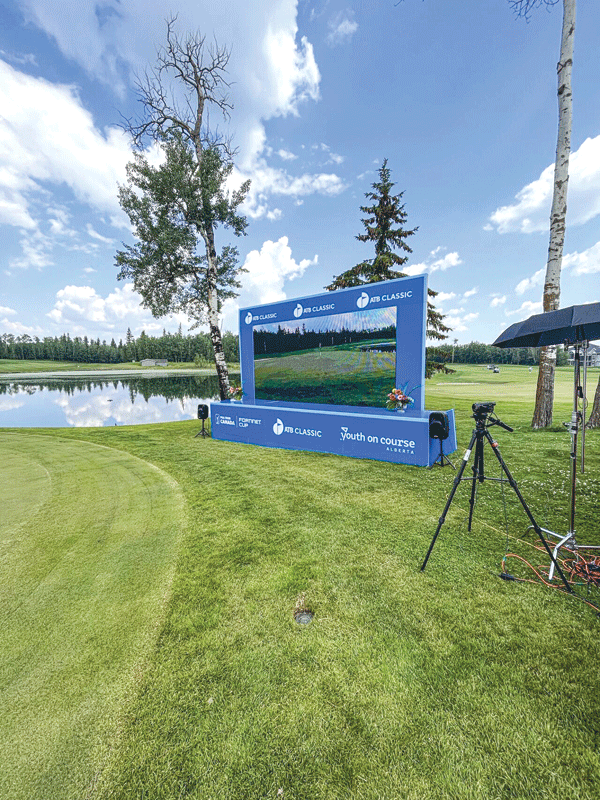
VueTronic has also taken part in special rental projects, such as the ATB Classic Professional Golfers’ Association (PGA) Tour.
BS: We navigate these challenges by consistently talking with sign shops, understanding municipality bylaws, coming up with signage options such as digital window posters or eye-catching indoor LED shelf-talkers, and having lots of projects pending in our sales funnel.
SMC: What are some of your future plans for the business, for the next five or 10 years?
BS: Getting involved in projects at an earlier stage would be a key strategy of ours. In so many instances, LEDs and signage are an afterthought. If we can work more closely with designers, planners, architects, digital integrators, and innovators early in the project’s conception, we’ll be able to incorporate the displays with ease and keep the intended integrity of the design concept.
TB: In the coming years, we hope to be the go-to brand for anybody who wants a quality LED display and known for our expertise in the industry.
SMC: Is there anything else you would like to add?
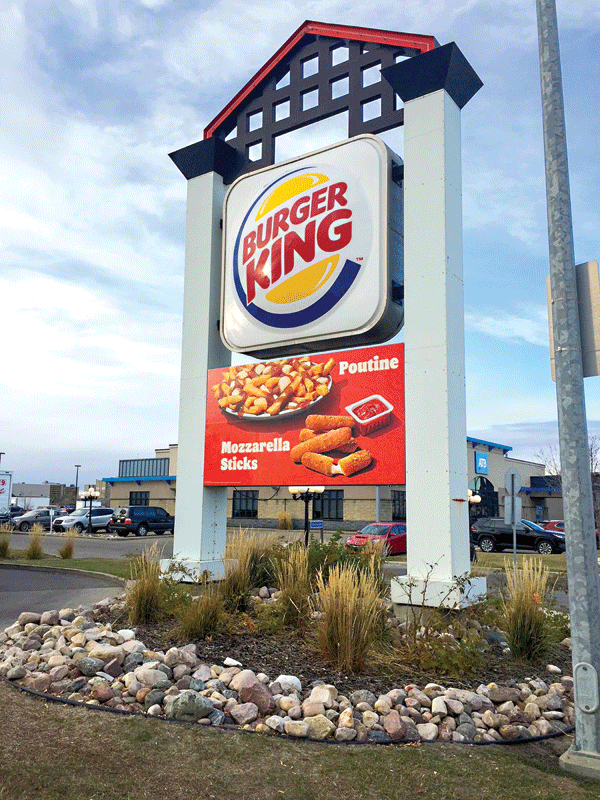
Sign solutions such as this digital board for a local Burger King can easily be updated using a simple tablet.
BS: LEDs and screens are everywhere. When we talk about our industry, it’s about being impactful and creative; making things easier, better, and more convenient for clients; and engaging with consumers. With the Internet of Things (IoT), smartphones, and everything else, technology is expanding at a staggering pace—and the LED industry is an integral part of that growth. LED displays are the future, and the future is coming. VueTronic is ready to help.





